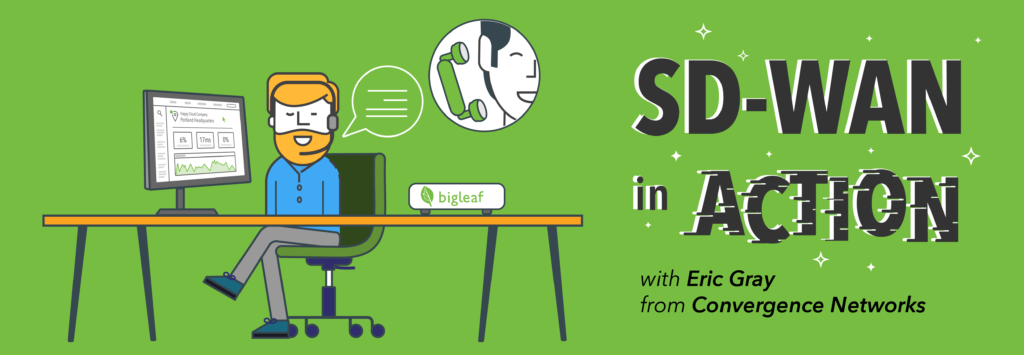MSP Convergence boosts customer satisfaction with Bigleaf

The cloud has fundamentally changed how small and mid-sized businesses think about their internet connection. Internet continuity is now a critical component of daily operations, employee productivity and customer experience. Yet these businesses still suffer daily frustrations, including dropped VoIP calls, grainy video conferencing, and unresponsive applications — all caused by underperforming internet connectivity.
MSPs who manage IT for these businesses need to be able to address these frustrations with a response that’s better than “we’ll let you know what the ISP says.” MSPs who leverage redundancy and intelligent software can provide their customers with the internet continuity and application experience that they expect.
But how do you ensure that continuity and experience without the pitfalls that have made traditional networking solutions so unappealing?
The answer according to one MSP? “Start the conversation now.”
Eric Gray, founder of Portland, Oregon-area MSP Convergence Networks, explained how his team relies on Bigleaf Networks to start a better conversation around internet connectivity — making internet continuity a reality for his customers.
As an MSP, how did you know that your customers needed a new strategy for internet connectivity?
It really started when our customers began moving technologies like VoIP phones, Microsoft 365, and video conferencing into the cloud. When our business started, we were the cost side of IT. Keep the server running. Keep the network working. Make sure the internet is plugged in. Now our conversations are way more focused on the application layer and keeping those cloud applications running the way they should.
Vendors have done a great job convincing those customers that moving to the cloud is easy. But to actually migrate a critical business application to the cloud without disrupting productivity requires planning and infrastructure. Networking is the piece that often gets overlooked in that process.
I’ve inherited clients who failed to plan their network properly for cloud applications, and it shows in the support tickets they send us. As those support tickets increased in regularity, we knew we needed a solution.
It sounds like that kind of negative customer experience could be a big challenge for MSPs. Have you seen that?
Absolutely. For the most part, our customers operate under all-you-can-eat agreements, and we have over 9,000 users. Anything we can do to make the phone not ring or a ticket not come into our system is time worth saving. It also generally means that our customers are more satisfied, always a good thing in the competitive MSP market.
Outages are the most obvious problem to impact customers’ cloud technologies. But we’ve found that a lot of the complaints come from more subtle internet performance issues like packet loss or latency — problems that still read as a live internet connection, but that make phone calls sound awful or keep applications from working the way they’re supposed to.
Those “things not working the way that they’re supposed to” problems are a bigger strain on the business than most MSPs realize. Those are the complaints that your service desk techs spend hours, days, weeks or months of energy trying to troubleshoot. Best case, you lost a lot of time and money in solving the problem. The worst case is your help desk thinks they’ve solved the problem because it went away, then the customer has the same problem and gets in touch with a different help desk guy and then another. That can go on for months because no one ever gets to the root cause of the issue until one day, the client gets pissed off. Then, as the MSP, you look bad because you didn’t put two and two together.
Sounds painful. What networking conversations could MSPs have with their customers to avoid all that?
As MSPs, we think in terms of disaster recovery and continuity. When you’re on-prem, it means redundant servers and BDRs. When you shift to the cloud that goes away. You now need to think about internet links and what your disaster recovery and continuity plans are for those.
You can’t just rely on one internet connection anymore. You need two connections or more. And if you have two, you need to think about things like load-balancing and instant failover. That means you need something like an SD-WAN solution to manage it.
That’s a conversation that should happen ahead of time, but folks don’t tend to give it the attention or care about it until they have a failure or a bottleneck. Then they care.
Did you try other SD-WAN solutions before Bigleaf?
At first, we tried to integrate a second circuit using the SD-WAN technology built into our customers’ firewalls. That felt like it should be an easy fix, but there were some inherent problems in that approach.
In that scenario, you’re selling it as a failover concept, but it doesn’t automatically failover because of the change in IP addresses and routing. So we’d say, “Yeah, we can put in this second link on this second port on your firewall, BUT when the internet goes down you’re gonna have to call us and we’re gonna have to reconfigure DNS. If you’re going to be down a whole day, we’ll do it. But if you’re gonna be down an hour, you’re better off just living with the outage. It was not elegant, to say the least.”
Not only did the customers not like paying for an internet connection that they were not using. But they would forget about our conversation. Then they’d get hit with an outage and ask us, ‘Why am I paying for this second circuit if it’s not going to help when the primary goes down?’ So they’re basically paying for a link just to sit there. They’re paying for a connection that you hope they never use, and it’s just not a good situation for the customer.
What impact has Bigleaf had on your business as a Managed Service Provider?
The value that Bigleaf has to an MSP goes beyond revenue and sales. It’s about having the phone ring less and having fewer support tickets come into the queue. It’s about having customers that you just don’t have those outage conversations with.
Anything that saves my team time frees up resources to add another client without adding more resources. An MSP is always trying to improve that, and Bigleaf fits right in there.
Here’s a real-world example. Early on a weekend morning, one of our clients had a major internet outage. They’re a 24/7 operation, so they started pinging us on Sunday at 2:00 AM. They were paging us every hour for updates and waking up my on-call person and my guy was hitting a breaking point because there was nothing we could do. It was a telco issue. He emailed back and said, “Would somebody please get a Bigleaf in here?”
When I hear that from one of my techs, all I think is: “Why don’t we have a redundant internet and Bigleaf in there?” If they had Bigleaf and a redundant internet, my guy would have never been woken up in the middle of the night. By having that conversation with the customer earlier, we could have avoided frustration for both the customer *and* my tech.
Any final thoughts for other MSPs who might want to consider Bigleaf as a solution for their customers?
Rarely does technology just work. I’ve never had an employee complain about Bigleaf, and I’ve never had a customer complain about Bigleaf. I keep waiting for it to stop doing what you promise, but it just freakin’ works.







